Imagine you're out for a ride, and your motorcycle suddenly stalls due to a flickering headlight—that's often a sign of underlying electrical issues. You might be wondering what causes these problems and how they can disrupt your journey. From aging batteries to faulty wiring and even ignition system failures, several factors can contribute to electrical malfunctions. Understanding these causes is essential, as they can lead to more serious complications if not addressed promptly. What are the specific signs you should look for to prevent a breakdown on the road?
Quick Takeaways
- Common electrical issues in motorcycles include dead batteries, faulty wiring, and malfunctioning ignition systems that disrupt performance.
- Battery age significantly impacts performance, with noticeable decline after 3-5 years resulting in starting difficulties and stalling.
- Corrosion on battery terminals and ground connections can cause poor electrical flow, leading to dim lights and intermittent starting problems.
- Regulator/rectifier malfunctions can lead to inconsistent voltage output, causing dead batteries and erratic performance in electrical systems.
Common Electrical Problems
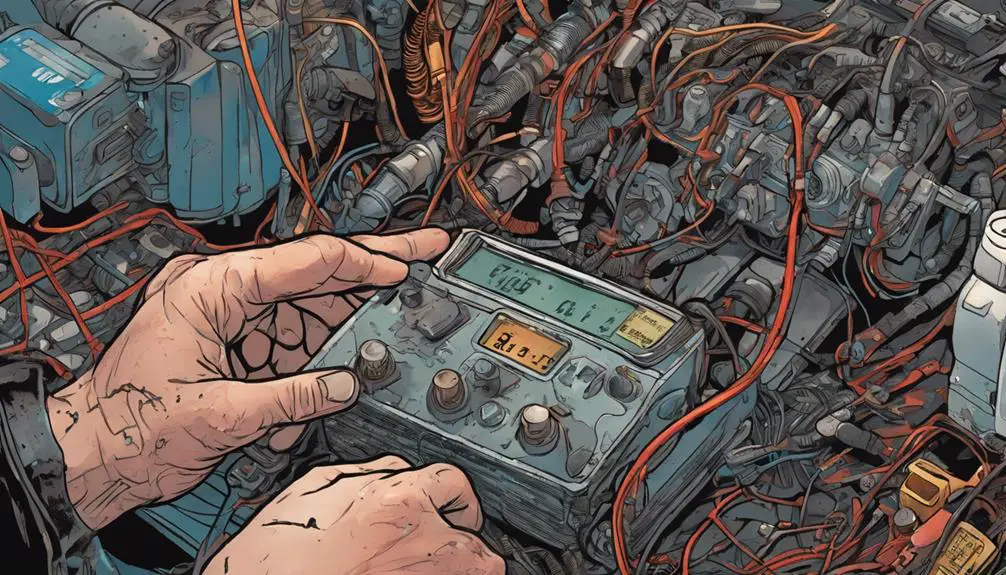
Motorcycles often experience common electrical problems like dead batteries, faulty wiring, and malfunctioning ignition systems that can leave you stranded on the road. These issues can stifle your freedom, making you feel trapped when you just want to hit the open highway.
Faulty wiring is a sneaky culprit. Over time, vibrations and exposure to the elements can wear down your wires, leading to shorts or disconnections that disrupt your ride. Keep an eye out for frayed wires or exposed connections; addressing them early can save you from a roadside headache.
Then there's the ignition system. If you twist that key and nothing happens, it can feel like a punch to your spirit. A malfunctioning ignition switch or a bad spark plug can rob you of that exhilarating roar of your engine.
Being proactive is key. Regular inspections can help you spot these electrical gremlins before they wreak havoc on your journey. Embrace the thrill of the ride, and don't let common electrical problems dim your passion for the open road.
Your motorcycle's freedom is your freedom—so keep it running strong and ready to go!
Battery Issues
When it comes to battery issues in motorcycles, you're often dealing with age, connection corrosion, and charging system failures.
Each of these factors can greatly impact your bike's performance and reliability.
Let's explore how they affect your ride and what you can do about them.
Battery Age Impact
Over time, a battery's performance can decline considerably, leading to various electrical issues in your motorcycle. As a motorcycle enthusiast, you know that a fully functioning battery is essential for releasing the freedom of the open road. When your battery ages, its ability to hold a charge decreases, which can result in unreliable starts, dim lights, and even stalling during rides.
If your battery's been in service for more than three to five years, it's time to assess its condition. You might start noticing that the engine cranks slower than it used to or that the lights flicker when you rev the throttle. These signs are your battery's way of saying it's nearing the end of its life.
Don't let a worn-out battery be the anchor that weighs you down. By replacing it proactively, you can guarantee your motorcycle remains your escape from the mundane. Embrace the thrill of riding with confidence, knowing your battery's got your back.
Stay liberated and ready for adventure—check your battery's age and performance regularly, and keep that freedom flowing.
Connection Corrosion Problems
Corrosion on battery terminals can lead to poor connections, causing frustrating starting issues and erratic electrical performance in your motorcycle. When you neglect those terminals, a buildup of corrosion forms, creating resistance that hinders the flow of electricity. This resistance can make starting your bike a real hassle, robbing you of the freedom that riding brings.
To combat this, you need to inspect your battery terminals regularly. Look for that chalky, white substance—it's a sign that corrosion is setting in. If you see it, don't just sit there; clean it up! Using a mixture of baking soda and water, scrub away the corrosion with a toothbrush or a wire brush. Make sure to disconnect the battery first to avoid shocks or damage.
After cleaning, reconnect the terminals tightly, ensuring a solid connection. This simple maintenance task can save you from being stranded or dealing with sudden electrical failures that disrupt your ride.
Charging System Failures
While maintaining clean battery terminals is important, issues with the charging system can also lead to significant battery problems that affect your motorcycle's performance. When you ride, you want freedom, not frustration.
Here are four common causes of charging system failures:
- Faulty Voltage Regulator: If this component isn't working, your battery mightn't receive the correct voltage, leading to overcharging or undercharging.
- Bad Stator: This generates the electrical current. If it's damaged or worn out, your battery won't get the charge it needs to operate reliably.
- Loose Connections: Even a slight disconnection can impede the flow of electricity, leaving you stranded when you least expect it.
- Worn Battery: A battery nearing its end can't hold a charge effectively, no matter how well the rest of the system functions.
Understanding these issues helps you maintain your bike's independence. You deserve a ride that's as liberating as the open road, so keep an eye on your charging system to guarantee your motorcycle stays powered up and ready for adventure.
Faulty Wiring
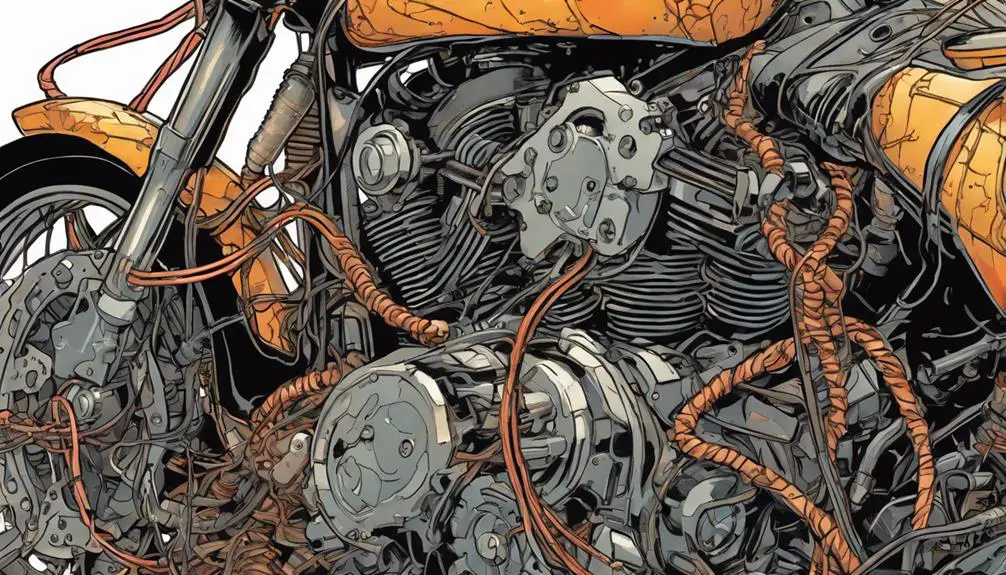
Faulty wiring is one of the most common culprits behind electrical issues in motorcycles, often leading to shorts, flickering lights, and even engine problems. You mightn't realize it, but the wiring harness is a complex network that carries power to various components. Over time, vibrations, heat, and exposure to the elements can cause insulation to wear down, leading to exposed wires that can short against each other or the bike frame.
When you're out on the open road, a little flicker in your lights can quickly escalate into a complete electrical failure if left unchecked. Regularly inspecting your wiring can help you catch issues early. Look for frayed wires, loose connections, or any signs of corrosion. If you notice anything unusual, it's best to address it before it spirals into a more significant problem.
You have the power to liberate yourself from these electrical headaches. By being proactive and vigilant, you can maintain a reliable and enjoyable ride. Don't underestimate the importance of your motorcycle's wiring; staying connected to your bike means staying free on the road.
Ignition System Failures
How often do you consider the impact of ignition system failures on your motorcycle's performance and reliability? Ignition issues can cripple your ride, making it essential to recognize the signs and address them swiftly.
Here are four common ignition system failures that could disrupt your journey:
- Faulty Spark Plugs: Worn or dirty spark plugs can lead to misfires, affecting acceleration and fuel efficiency.
- Weak Ignition Coil: A failing ignition coil can result in weak sparks, causing rough idling and difficulty starting your bike.
- Broken Ignition Switch: If your ignition switch is malfunctioning, you might find yourself stranded, unable to start your engine.
- Timing Issues: Incorrect ignition timing can lead to poor engine performance, knocking, or even complete failure to start.
Understanding these potential failures empowers you to maintain your motorcycle better. Regular checks and timely replacements can help you release the full potential of your ride.
Don't let ignition issues hold you back; take charge and guarantee your motorcycle runs smoothly, allowing you to enjoy the freedom of the open road.
Ground Connection Problems
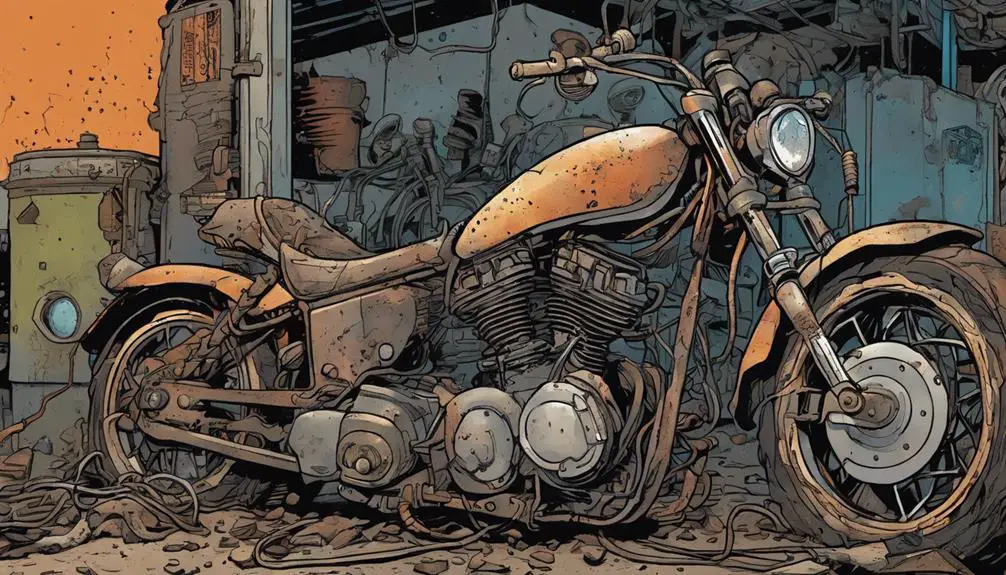
Ignition system failures aren't the only culprits behind motorcycle performance issues; ground connection problems can also wreak havoc on your bike's electrical system. When the ground connections are loose or corroded, it creates resistance that disrupts the flow of electricity, leading to erratic performance. You might notice dim lights, intermittent starting issues, or electrical components that just won't work.
To liberate your ride from these frustrating problems, start by inspecting the ground connections. Check the battery terminals and verify they're tight and clean. Corrosion is a silent enemy that can undermine your motorcycle's electrical integrity, so scrub away any signs with a wire brush.
Don't forget to trace the ground wire to the frame; a solid connection is essential. If you find any frayed or damaged wires, replace them immediately.
Regulator/Rectifier Malfunctions
Regulator/rectifier malfunctions can lead to inconsistent voltage output, causing your motorcycle's electrical system to struggle. When this essential component fails, it can severely impact your ride, limiting your freedom on the open road.
Here are four key symptoms to watch out for:
- Dim or Flickering Lights: If your headlights or dashboard lights are flickering, it's a strong indicator of voltage issues.
- Dead Battery: A malfunctioning regulator/rectifier can prevent your battery from charging properly, leaving you stranded.
- Overheating: Excessive heat from the regulator/rectifier can indicate it's working overtime, which can lead to further failure.
- Erratic Performance: If your motorcycle's performance feels off, with unpredictable power delivery, it could stem from inconsistent voltage supply.
When you notice any of these signs, it's essential to address the issue promptly. Ignoring it can lead to more extensive electrical problems, limiting your motorcycle's reliability and your riding freedom.
Trust your instincts; if something feels off, investigate it. Your adventure waits, and a smooth-running motorcycle is key to experiencing the liberation of the open road.
Fuses and Circuit Breakers
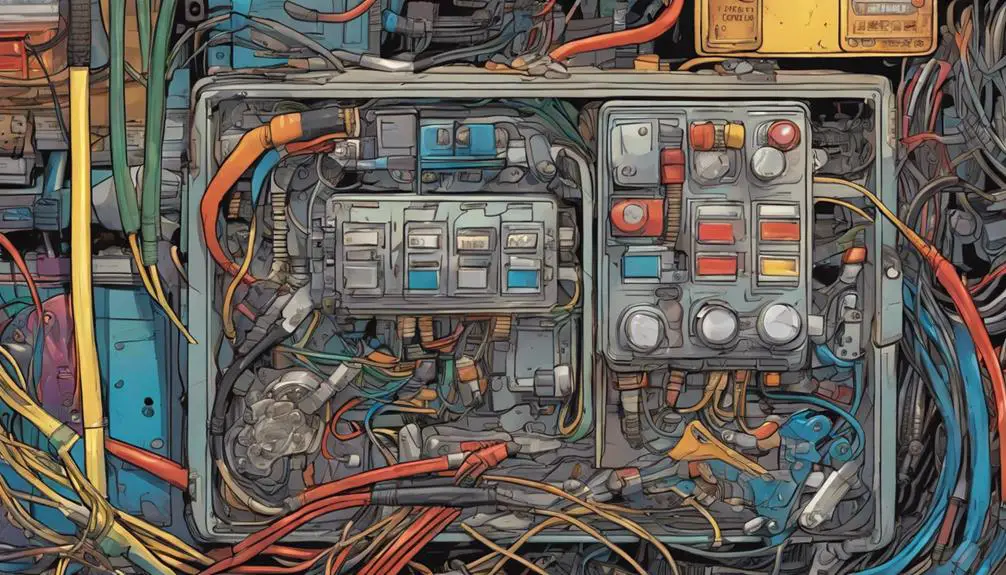
Fuses and circuit breakers act as essential safety devices in your motorcycle's electrical system, protecting it from overloads and short circuits. These components are your first line of defense against electrical failures that could leave you stranded or, worse, cause damage to your bike. When your electrical system draws too much current, a fuse will blow or a circuit breaker will trip, interrupting the flow of electricity and preventing further issues.
If you've ever experienced a sudden loss of power or malfunctioning lights, it might be due to a blown fuse. Checking and replacing fuses is a straightforward task that empowers you to maintain your freedom on the road. Circuit breakers, on the other hand, can be reset, allowing you to regain power without needing replacement parts.
You should regularly inspect these safety devices as part of your maintenance routine. Understanding their role helps you appreciate the intricate design of your motorcycle and the freedom it offers. Embrace this knowledge; it puts you in control of your ride, ensuring you can conquer the open road with confidence, knowing you've got safety measures in place.
Starter Motor Troubles
When your motorcycle won't start, the starter motor might be the culprit.
You'll want to look at common starter motor failures and learn some diagnostic testing techniques to pinpoint the issue.
Understanding these aspects can save you time and hassle on the road.
Common Starter Motor Failures
Starter motors often break down due to wear and tear, poor connections, or electrical shorts that can leave you stranded. It's essential to recognize common failures to keep your ride smooth and free from interruptions.
Here are four prevalent issues to watch for:
- Worn Brushes: Over time, the brushes inside the starter motor can wear down, leading to insufficient contact and power loss.
- Defective Solenoid: If the solenoid fails, it won't send power from the battery to the starter motor, preventing your bike from starting.
- Failed Bearings: Bearings can wear out, causing friction and overheating, which can ultimately lead to complete motor failure.
- Corroded Connections: Poor connections, often due to corrosion, can block the electrical flow necessary for starting your motorcycle.
Diagnostic Testing Techniques
To effectively diagnose starter motor troubles, you'll want to utilize a combination of electrical testing tools to pinpoint the exact issue.
Start by checking the battery voltage; it should be around 12.6 volts when fully charged. If it's low, recharge or replace the battery.
Next, use a multimeter to test the voltage at the starter motor. When you engage the starter, the voltage should remain above 10 volts. If it drops considerably, you might have a bad connection or a failing starter relay.
Don't forget to inspect the starter motor itself. A visual check can reveal loose connections or corroded terminals.
If everything looks good and you're still having issues, perform a bench test on the starter motor. This involves removing it and connecting it directly to a power source to see if it spins freely.
Diagnostic Tools and Techniques
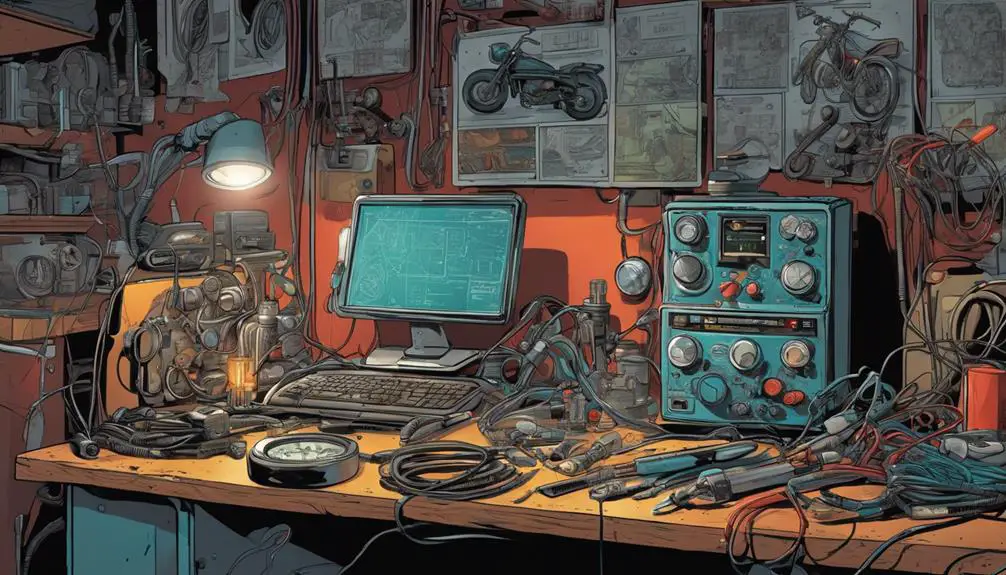
Using the right diagnostic tools and techniques can help you quickly identify electrical issues in your motorcycle. When you're on the road, freedom is paramount, and the last thing you want is to be stranded due to an electrical failure.
Here's what you'll need:
- Multimeter: This essential tool measures voltage, current, and resistance, allowing you to assess the health of your electrical system.
- Test Light: A simple yet effective way to check for power at various points in the circuit, helping you pinpoint issues quickly.
- Wiring Diagrams: These provide a clear visual representation of your motorcycle's electrical system, guiding you through troubleshooting.
- Battery Tester: Ensuring your battery's charge and health is vital; a tester can reveal if it's time for a replacement.
With these tools, you'll empower yourself to tackle electrical problems head-on.
Regular diagnostics not only save time and money but also enhance your riding experience. So gear up, embrace your freedom, and take control of your motorcycle's electrical health!
Common Questions
Can Weather Affect Electrical Performance in Motorcycles?
Absolutely, weather can greatly affect electrical performance in your motorcycle.
When it rains, moisture can seep into connections and components, leading to short circuits or corrosion.
Cold temperatures might cause battery issues, while extreme heat can strain electrical systems.
You've got to stay vigilant, especially during drastic weather changes.
Keeping your bike clean and well-maintained helps shield it from these elements, so you can ride freely and confidently, no matter the forecast.
How Often Should Motorcycle Electrical Systems Be Inspected?
Think of your motorcycle's electrical system as the beating heart of your ride; it needs regular check-ups to keep the pulse strong.
You should inspect it every six months, especially before long trips. Just like a well-tuned engine fuels your freedom, a healthy electrical system guarantees you're not left stranded.
Are Aftermarket Accessories Safe for My Motorcycle's Electrical System?
When you're considering aftermarket accessories, it's crucial to verify they're compatible with your motorcycle's electrical system.
Poorly designed accessories can lead to shorts or overloads, risking your bike's performance.
Always check for quality and user reviews, and consider consulting a professional if you're unsure.
You want to enhance your ride, not hinder it.
What Are Signs of Impending Electrical Failure in Motorcycles?
Did you know that nearly 30% of motorcycle breakdowns stem from electrical failures?
To keep your ride liberating and smooth, watch for signs like flickering lights, difficulty starting, or unusual battery drainage.
If you hear strange noises from the electrical system or notice corrosion on battery terminals, don't ignore them. These could signal impending trouble.
Staying alert to these signs helps you maintain your freedom on the road and avoid costly repairs.
How Can Improper Storage Impact Motorcycle Electrical Components?
Improper storage can seriously impact your motorcycle's electrical components.
When you leave your bike exposed to moisture or extreme temperatures, it can cause corrosion or damage to wires and connectors. You might find that batteries drain faster or even fail prematurely.
To keep your ride in top shape, always store it in a dry, temperature-controlled environment, and consider using a battery tender.
Taking these steps can help you maintain your freedom on the road!
Wrapping Up
In the world of motorcycles, electrical issues can feel like dark clouds looming over your ride.
By staying proactive with inspections and maintenance, you can chase those clouds away before they release a storm.
Remember, the heart of your bike is its electrical system, and keeping it healthy guarantees smooth journeys ahead.
Don't let small problems snowball; tackle them head-on to keep your adventures bright and full of life.
Your freedom on two wheels depends on it!